fuel type FIAT DUCATO BASE CAMPER 2018 Owner handbook (in English)
[x] Cancel search | Manufacturer: FIAT, Model Year: 2018, Model line: DUCATO BASE CAMPER, Model: FIAT DUCATO BASE CAMPER 2018Pages: 304, PDF Size: 14.93 MB
Page 42 of 304
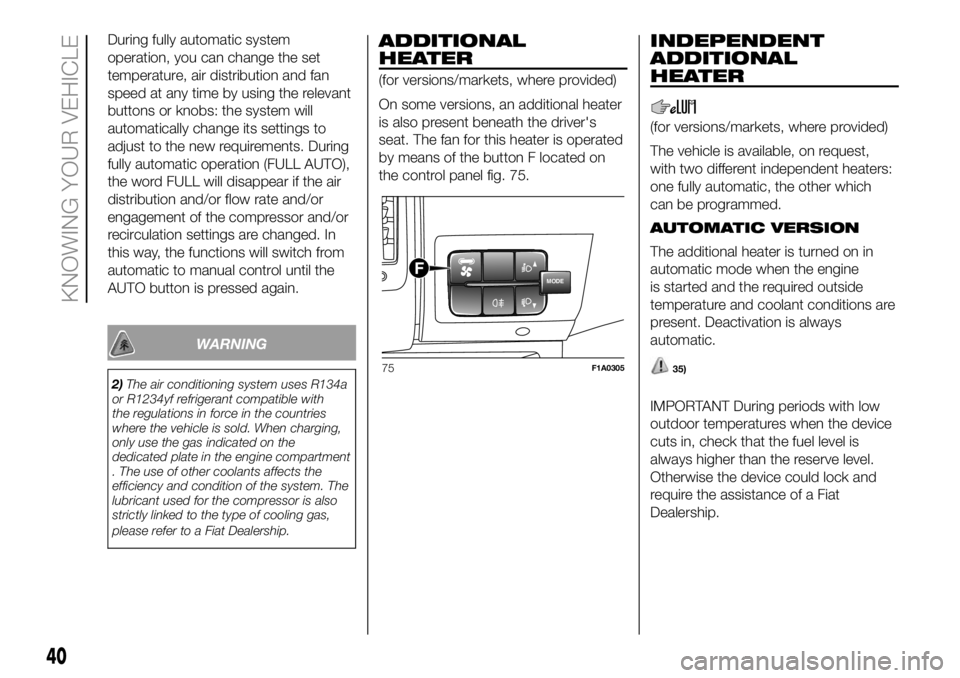
During fully automatic system
operation, you can change the set
temperature, air distribution and fan
speed at any time by using the relevant
buttons or knobs: the system will
automatically change its settings to
adjust to the new requirements. During
fully automatic operation (FULL AUTO),
the word FULL will disappear if the air
distribution and/or flow rate and/or
engagement of the compressor and/or
recirculation settings are changed. In
this way, the functions will switch from
automatic to manual control until the
AUTO button is pressed again.
WARNING
2)The air conditioning system uses R134a
or R1234yf refrigerant compatible with
the regulations in force in the countries
where the vehicle is sold. When charging,
only use the gas indicated on the
dedicated plate in the engine compartment
. The use of other coolants affects the
efficiency and condition of the system. The
lubricant used for the compressor is also
strictly linked to the type of cooling gas,
please refer to a Fiat Dealership.
ADDITIONAL
HEATER
(for versions/markets, where provided)
On some versions, an additional heater
is also present beneath the driver's
seat. The fan for this heater is operated
by means of the button F located on
the control panel fig. 75.
INDEPENDENT
ADDITIONAL
HEATER
(for versions/markets, where provided)
The vehicle is available, on request,
with two different independent heaters:
one fully automatic, the other which
can be programmed.
AUTOMATIC VERSION
The additional heater is turned on in
automatic mode when the engine
is started and the required outside
temperature and coolant conditions are
present. Deactivation is always
automatic.
35)
IMPORTANT During periods with low
outdoor temperatures when the device
cuts in, check that the fuel level is
always higher than the reserve level.
Otherwise the device could lock and
require the assistance of a Fiat
Dealership.
MODEF
75F1A0305
40
KNOWING YOUR VEHICLE
Page 94 of 304

Presence of snow or ice on the
wheels or the wheel arches.
Use of snow chains.
Use of wheels/tyres not equipped
with TPMS sensors.
The space-saver wheel is not
equipped with the tyre pressure control
sensor. Therefore, the tyre pressure is
not controlled by the system.
If the space-saver wheel replaces a
tyre with a pressure lower than the
insufficient pressure limit, an acoustic
signal will be emitted and the
warning light will turn on at the next
start-up.
When the original tyre is repaired or
replaced and it is mounted back on
the vehicle to replace the space-saver
wheel, the TPMS will update
automatically and the warning light will
switch off, provided that the pressure of
none of the four tyres is below the
insufficient pressure limit. You may need
to drive the vehicle for about 20
minutes at a speed higher than 20
km/h to allow the TPMS to receive this
information.
WARNING
69)The TPMS is optimised for the original
tyres and wheels provided. TPMS
pressures and alerts have been defined
according to the size of the tyres mounted
on the vehicle. Using equipment with
different size, type or kind may cause
irregular system operation or sensor
damage. Non-original spare wheels can
damage the sensor. Do not use tyre
sealant or balancing weights if the vehicle
is equipped with TPMS as these may
damage the sensors.
70)If the system signals a pressure
decrease on a specific tyre, it is
recommended to check the pressure on all
four tyres.
71)The TPMS does not relieve the driver
from the obligation to check the tyre
pressure every month; it is not even to be
considered a replacing system for
maintenance or a safety system.
72)Tyre pressure must be checked with
tyres cold. Should it become necessary for
whatever reason to check pressure with
warm tyres, do not reduce pressure even
though it is higher than the prescribed
value, but repeat the check when tyres are
cold.
73)The TPMS cannot indicate sudden tyre
pressure drops (for example when a tyre
bursts). In this case, stop the vehicle,
braking with caution and avoiding abrupt
steering.74)The system only warns that the tyre
pressure is low: it is not able to inflate
them.
75)Insufficient tyre inflation increases fuel
consumption, reduces the tread duration
and may affect your ability to drive the
vehicle safely.
76)Always refit the valve stem cap after
inspecting or adjusting tyre pressure. This
prevents dampness or dirt from entering
the valve stem and thus the pressure
control sensor from being damaged.
77)The tyre repair kit (Fix&Go) provided
with the vehicle (for versions/markets,
where provided) is compatible with the
TPMS sensors; using sealants not
equivalent with that in the original kit may
adversely affect its operation. If sealants
not equivalent with the original ones are
used, it is recommended to have the
TPMS sensor operation checked by a
qualified repair centre.
92
SAFETY
Page 127 of 304
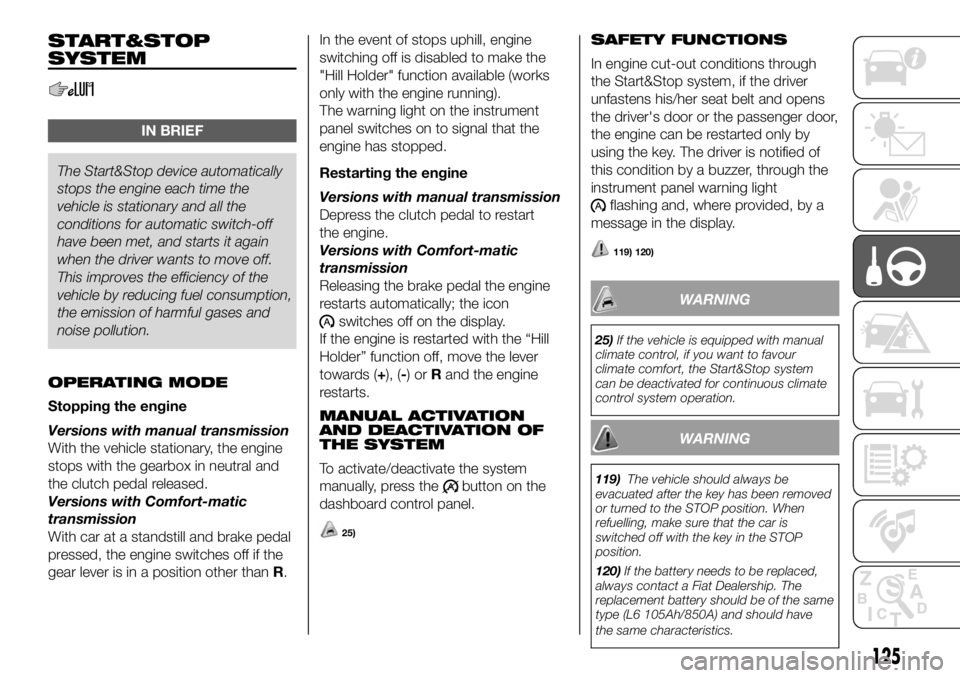
START&STOP
SYSTEM
IN BRIEF
The Start&Stop device automatically
stops the engineeach time the
vehicle is stationary and all the
conditions for automatic switch-off
have been met, and starts it again
when the driver wants to move off.
This improves the efficiency of the
vehicle by reducing fuel consumption,
the emission of harmful gases and
noise pollution.
OPERATING MODE
Stopping the engine
Versions with manual transmission
With the vehicle stationary, the engine
stops with the gearbox in neutral and
the clutch pedal released.
Versions with Comfort-matic
transmission
With car at a standstill and brake pedal
pressed, the engine switches off if the
gear lever is in a position other thanR.In the event of stops uphill, engine
switching off is disabled to make the
"Hill Holder" function available (works
only with the engine running).
The warning light on the instrument
panel switches on to signal that the
engine has stopped.
Restarting the engine
Versions with manual transmission
Depress the clutch pedal to restart
the engine.
Versions with Comfort-matic
transmission
Releasing the brake pedal the engine
restarts automatically; the icon
switches off on the display.
If the engine is restarted with the “Hill
Holder” function off, move the lever
towards (+), (-)orRand the engine
restarts.
MANUAL ACTIVATION
AND DEACTIVATION OF
THE SYSTEM
To activate/deactivate the system
manually, press the
button on the
dashboard control panel.
25)
SAFETY FUNCTIONS
In engine cut-out conditions through
the Start&Stop system, if the driver
unfastens his/her seat belt and opens
the driver's door or the passenger door,
the engine can be restarted only by
using the key. The driver is notified of
this condition by a buzzer, through the
instrument panel warning light
flashing and, where provided, by a
message in the display.
119) 120)
WARNING
25)If the vehicle is equipped with manual
climate control, if you want to favour
climate comfort, the Start&Stop system
can be deactivated for continuous climate
control system operation.
WARNING
119)The vehicle should always be
evacuated after the key has been removed
or turned to the STOP position. When
refuelling, make sure that the car is
switched off with the key in the STOP
position.
120)If the battery needs to be replaced,
always contact a Fiat Dealership. The
replacement battery should be of the same
type (L6 105Ah/850A) and should have
the same characteristics.
125
Page 138 of 304
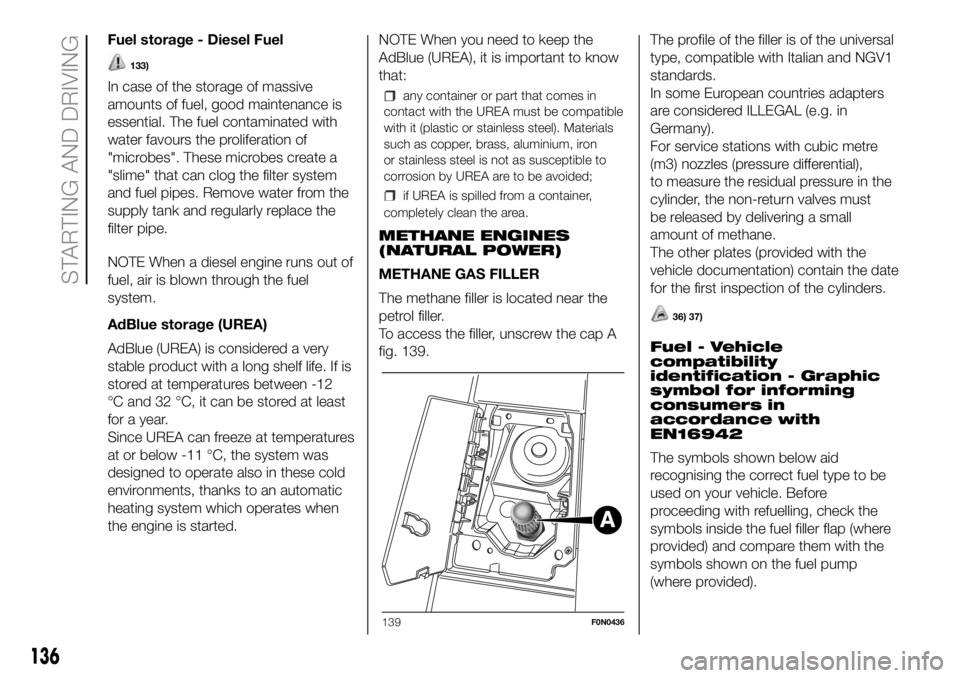
Fuel storage - Diesel Fuel
133)
In case of the storage of massive
amounts of fuel, good maintenance is
essential. The fuel contaminated with
water favours the proliferation of
"microbes". These microbes create a
"slime" that can clog the filter system
and fuel pipes. Remove water from the
supply tank and regularly replace the
filter pipe.
NOTE When a diesel engine runs out of
fuel, air is blown through the fuel
system.
AdBlue storage (UREA)
AdBlue (UREA) is considered a very
stable product with a long shelf life. If is
stored at temperatures between -12
°C and 32 °C, it can be stored at least
for a year.
Since UREA can freeze at temperatures
at or below -11 °C, the system was
designed to operate also in these cold
environments, thanks to an automatic
heating system which operates when
the engine is started.NOTE When you need to keep the
AdBlue (UREA), it is important to know
that:any container or part that comes in
contact with the UREA must be compatible
with it (plastic or stainless steel). Materials
such as copper, brass, aluminium, iron
or stainless steel is not as susceptible to
corrosion by UREA are to be avoided;
if UREA is spilled from a container,
completely clean the area.
METHANE ENGINES
(NATURAL POWER)
METHANE GAS FILLER
The methane filler is located near the
petrol filler.
To access the filler, unscrew the cap A
fig. 139.The profile of the filler is of the universal
type, compatible with Italian and NGV1
standards.
In some European countries adapters
are considered ILLEGAL (e.g. in
Germany).
For service stations with cubic metre
(m3) nozzles (pressure differential),
to measure the residual pressure in the
cylinder, the non-return valves must
be released by delivering a small
amount of methane.
The other plates (provided with the
vehicle documentation) contain the date
for the first inspection of the cylinders.
36) 37)
Fuel - Vehicle
compatibility
identification - Graphic
symbol for informing
consumers in
accordance with
EN16942
The symbols shown below aid
recognising the correct fuel type to be
used on your vehicle. Before
proceeding with refuelling, check the
symbols inside the fuel filler flap (where
provided) and compare them with the
symbols shown on the fuel pump
(where provided).
139F0N0436
136
STARTING AND DRIVING
Page 139 of 304

Symbols for petrol/methane bi-fuel
cars
E5: Unleaded petrol containing up to
2.7% (m/m) oxygen and with maximum
5.0% (V/V) ethanol compliant with
EN228
E10: Unleaded petrol containing up to
3.7% (m/m) oxygen and with maximum
10.0% (V/V) ethanol compliant with
EN228
CNG: Automotive methane and
bio-methane compliant withEN16723
Symbols for diesel powered cars
B7: Diesel containing up to 7% (V/V) of
FAME (Fatty Acid Methyl Esters)
compliant with theEN590specification
B10: Diesel containing up to 10%
(V/V) of FAME (Fatty Acid Methyl Esters)
compliant with theEN16734
specification
WARNING
129)Do not approach naked flames or lit
cigarettes to the fuel tank filler: fire risk.
Keep your face away from the fuel filler to
prevent breathing in harmful vapours.
130)To avoid fuel spillage and the
exceeding of the maximum level, avoid
topping up after filling the tank.
131)Any fuel pumping in portable
containers located on a floor can cause a
fire. Danger of burns. Always put the fuel
container on the ground during filling. Avoid
using contaminated fuel: a fuel
contaminated with water or earth can
cause serious damage to the motor supply.
Proper maintenance of the fuel filter, of
the engine and the fuel tank is essential.
132)If AdBlue overheats for a prolonged
period inside the tank to over 50 ° C (for
example due to direct solar irradiation),
AdBlue can decompose ammonia vapours.
Ammonia vapours have a pungent odour
when the cap of the AdBlue tank is
unscrewed, therefore be careful not to
inhale any ammonia vapours in the tank
outlet. In this concentration, however, the
ammonia vapors are not harmful or
dangerous to health.
133)Do not open the fuel system at high
pressure with the engine running. The
operation of the engine creates a high fuel
pressure. A jet of high-pressure fuel can
cause serious injury or death.
WARNING
35)Only refuel with automotive diesel
complying with the European specification
EN 590. The use of other products or
mixtures may damage the engine beyond
repair and consequently invalidate the
warranty, due to the damage caused. If
you accidentally introduce other types of
fuel into the tank, do not start the engine.
Empty the tank. If the engine has been run
for even an extremely limited amount of
time, you must not only drain the fuel tank,
but the rest of the supply circuit as well.
36)Methane refuelling stations are not
authorised to refill the cylinders when the
inspection date has expired. The check
valve prevents the methane from flowing
back to the fuel filler.
37)If the vehicle has been registered in a
country other than Italy, the certification
data, identification and inspection
procedures for the methane cylinders
should conform to the legislation in that
country. In any case, it should be
remembered that the life of the cylinders is
20 years from the production date as set
out in ECE Regulation no. 110.
137
Page 186 of 304
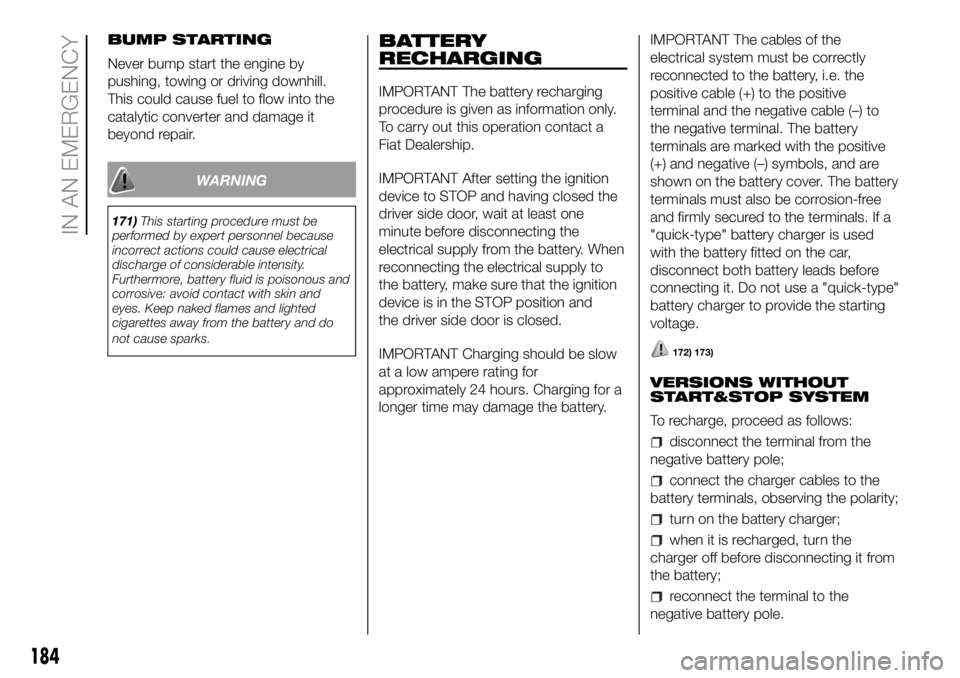
BUMP STARTING
Never bump start the engine by
pushing, towing or driving downhill.
This could cause fuel to flow into the
catalytic converter and damage it
beyond repair.
WARNING
171)This starting procedure must be
performed by expert personnel because
incorrect actions could cause electrical
discharge of considerable intensity.
Furthermore, battery fluid is poisonous and
corrosive: avoid contact with skin and
eyes. Keep naked flames and lighted
cigarettes away from the battery and do
not cause sparks.
BATTERY
RECHARGING
IMPORTANT The battery recharging
procedure is given as information only.
To carry out this operation contact a
Fiat Dealership.
IMPORTANT After setting the ignition
device to STOP and having closed the
driver side door, wait at least one
minute before disconnecting the
electrical supply from the battery. When
reconnecting the electrical supply to
the battery, make sure that the ignition
device is in the STOP position and
the driver side door is closed.
IMPORTANT Charging should be slow
at a low ampere rating for
approximately 24 hours. Charging for a
longer time may damage the battery.IMPORTANT The cables of the
electrical system must be correctly
reconnected to the battery, i.e. the
positive cable (+) to the positive
terminal and the negative cable (–) to
the negative terminal. The battery
terminals are marked with the positive
(+) and negative (–) symbols, and are
shown on the battery cover. The battery
terminals must also be corrosion-free
and firmly secured to the terminals. If a
"quick-type" battery charger is used
with the battery fitted on the car,
disconnect both battery leads before
connecting it. Do not use a "quick-type"
battery charger to provide the starting
voltage.
172) 173)
VERSIONS WITHOUT
START&STOP SYSTEM
To recharge, proceed as follows:
disconnect the terminal from the
negative battery pole;
connect the charger cables to the
battery terminals, observing the polarity;
turn on the battery charger;
when it is recharged, turn the
charger off before disconnecting it from
the battery;
reconnect the terminal to the
negative battery pole.
184
IN AN EMERGENCY
Page 221 of 304
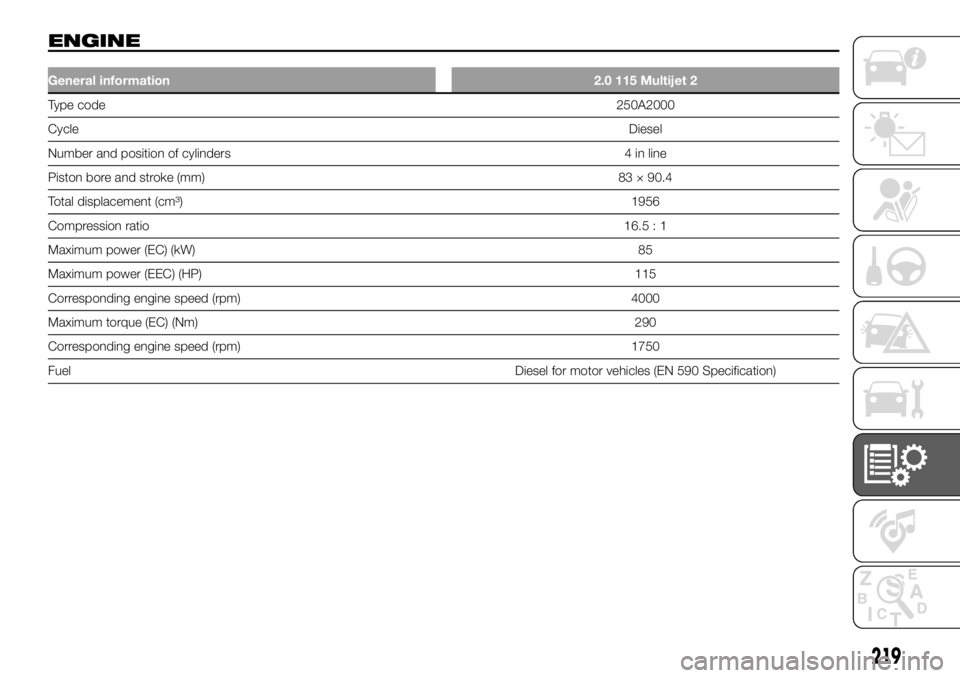
ENGINE
General information2.0 115 Multijet 2
Type code250A2000
CycleDiesel
Number and position of cylinders 4 in line
Piston bore and stroke (mm)83 × 90.4
Total displacement (cm³)1956
Compression ratio16.5 : 1
Maximum power (EC) (kW)85
Maximum power (EEC) (HP)115
Corresponding engine speed (rpm) 4000
Maximum torque (EC) (Nm)290
Corresponding engine speed (rpm) 1750
FuelDiesel for motor vehicles (EN 590 Specification)
219
Page 222 of 304
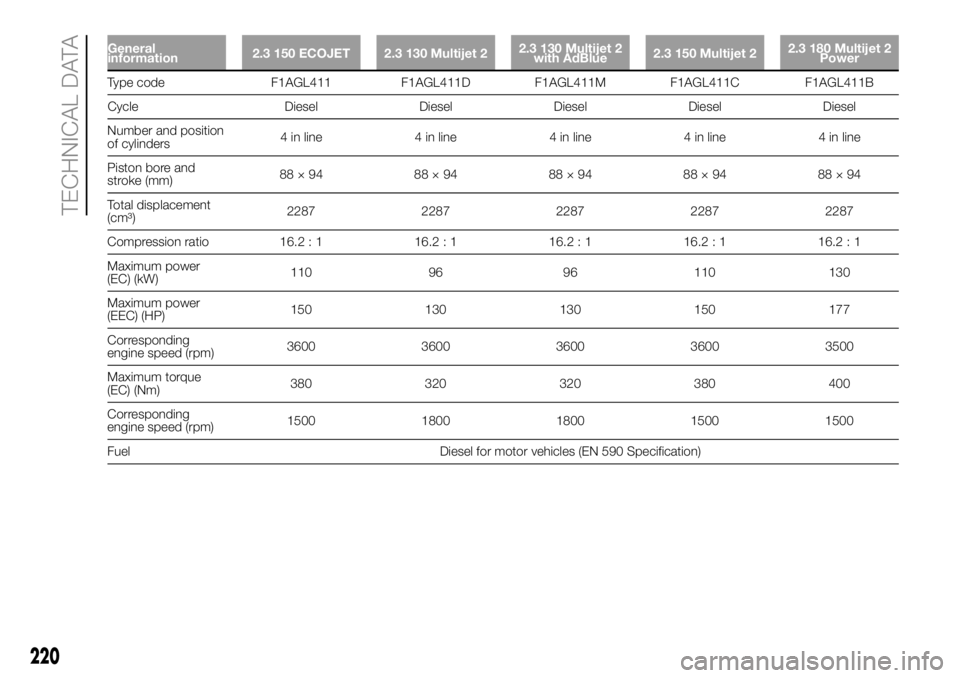
General
information2.3 150 ECOJET 2.3 130 Multijet 22.3 130 Multijet 2
with AdBlue2.3 150 Multijet 22.3 180 Multijet 2
Power
Type code F1AGL411 F1AGL411D F1AGL411M F1AGL411C F1AGL411B
Cycle Diesel Diesel Diesel Diesel Diesel
Number and position
of cylinders4 in line 4 in line 4 in line 4 in line 4 in line
Piston bore and
stroke (mm)88×94 88×94 88×94 88×94 88×94
Total displacement
(cm³)2287 2287 2287 2287 2287
Compression ratio 16.2 : 1 16.2 : 1 16.2 : 1 16.2 : 1 16.2 : 1
Maximum power
(EC) (kW)110 96 96 110 130
Maximum power
(EEC) (HP)150 130 130 150 177
Corresponding
engine speed (rpm)3600 3600 3600 3600 3500
Maximum torque
(EC) (Nm)380 320 320 380 400
Corresponding
engine speed (rpm)1500 1800 1800 1500 1500
Fuel Diesel for motor vehicles (EN 590 Specification)
220
TECHNICAL DATA
Page 223 of 304
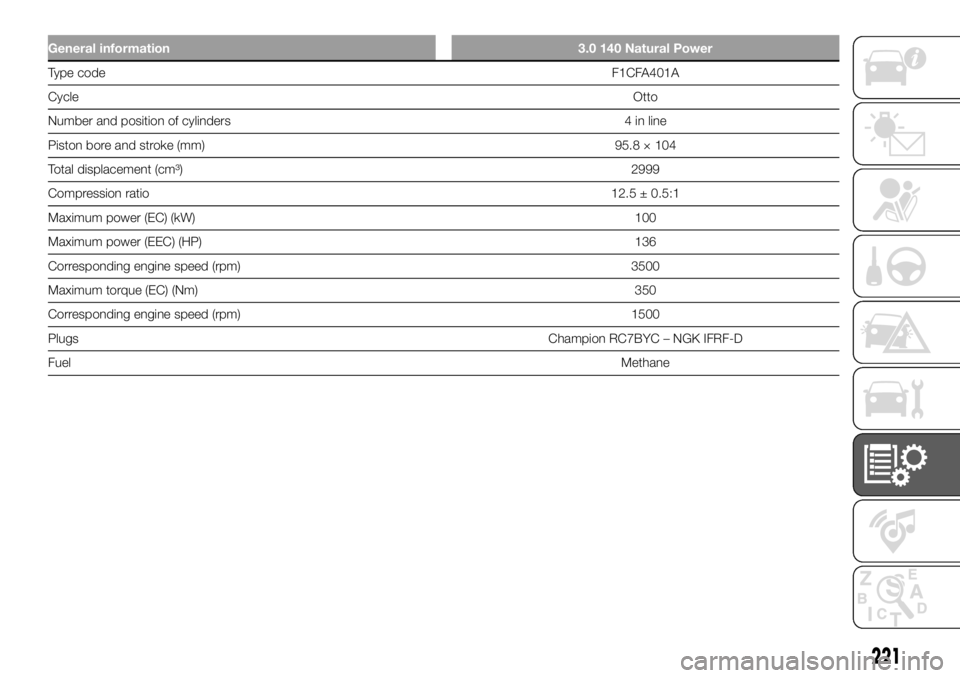
General information 3.0 140 Natural Power
Type codeF1CFA401A
CycleOtto
Number and position of cylinders 4 in line
Piston bore and stroke (mm) 95.8 × 104
Total displacement (cm³)2999
Compression ratio12.5 ± 0.5:1
Maximum power (EC) (kW)100
Maximum power (EEC) (HP)136
Corresponding engine speed (rpm) 3500
Maximum torque (EC) (Nm)350
Corresponding engine speed (rpm) 1500
PlugsChampion RC7BYC – NGK IFRF-D
FuelMethane
221
Page 248 of 304
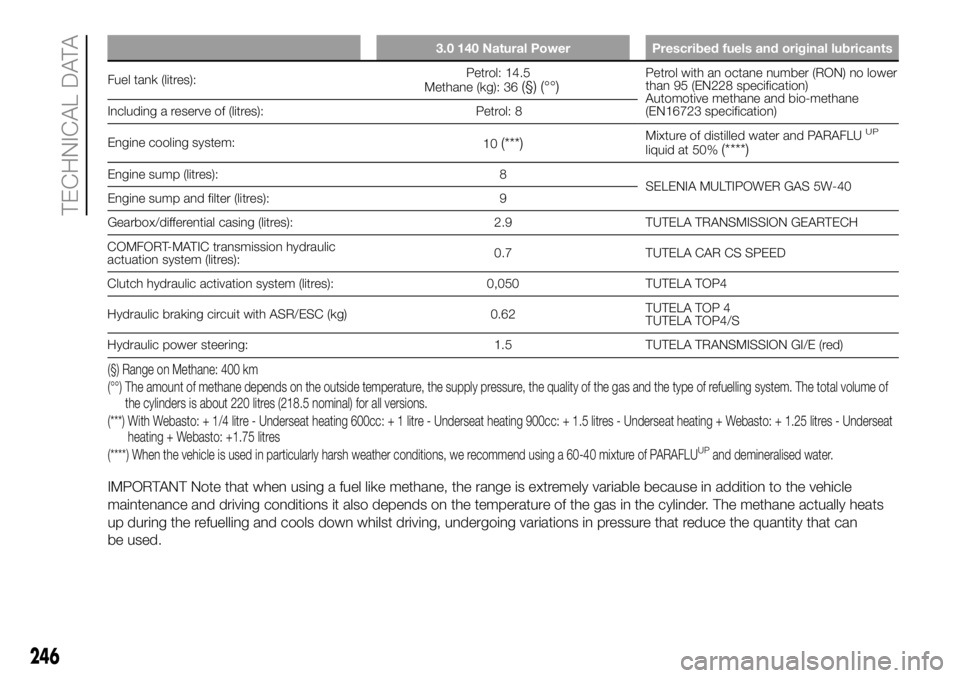
3.0 140 Natural Power Prescribed fuels and original lubricants
Fuel tank (litres):Petrol: 14.5
Methane (kg): 36(§) (°°)Petrol with an octane number (RON) no lower
than 95 (EN228 specification)
Automotive methane and bio-methane
(EN16723 specification) Including a reserve of (litres): Petrol: 8
Engine cooling system:
10
(***)Mixture of distilled water and PARAFLUUP
liquid at 50%(****)
Engine sump (litres): 8
SELENIA MULTIPOWER GAS 5W-40
Engine sump and filter (litres): 9
Gearbox/differential casing (litres): 2.9 TUTELA TRANSMISSION GEARTECH
COMFORT-MATIC transmission hydraulic
actuation system (litres):0.7 TUTELA CAR CS SPEED
Clutch hydraulic activation system (litres): 0,050 TUTELA TOP4
Hydraulic braking circuit with ASR/ESC (kg) 0.62TUTELA TOP 4
TUTELA TOP4/S
Hydraulic power steering: 1.5 TUTELA TRANSMISSION GI/E (red)
(§) Range on Methane: 400 km
(°°) The amount of methane depends on the outside temperature, the supply pressure, the quality of the gas and the type of refuelling system. The total volume of
the cylinders is about 220 litres (218.5 nominal) for all versions.
(***) With Webasto: + 1/4 litre - Underseat heating 600cc: + 1 litre - Underseat heating 900cc: + 1.5 litres - Underseat heating + Webasto: + 1.25 litres - Underseat
heating + Webasto: +1.75 litres
(****) When the vehicle is used in particularly harsh weather conditions, we recommend using a 60-40 mixture of PARAFLU
UPand demineralised water.
IMPORTANT Note that when using a fuel like methane, the range is extremely variable because in addition to the vehicle
maintenance and driving conditions it also depends on the temperature of the gas in the cylinder. The methane actually heats
up during the refuelling and cools down whilst driving, undergoing variations in pressure that reduce the quantity that can
be used.
246
TECHNICAL DATA